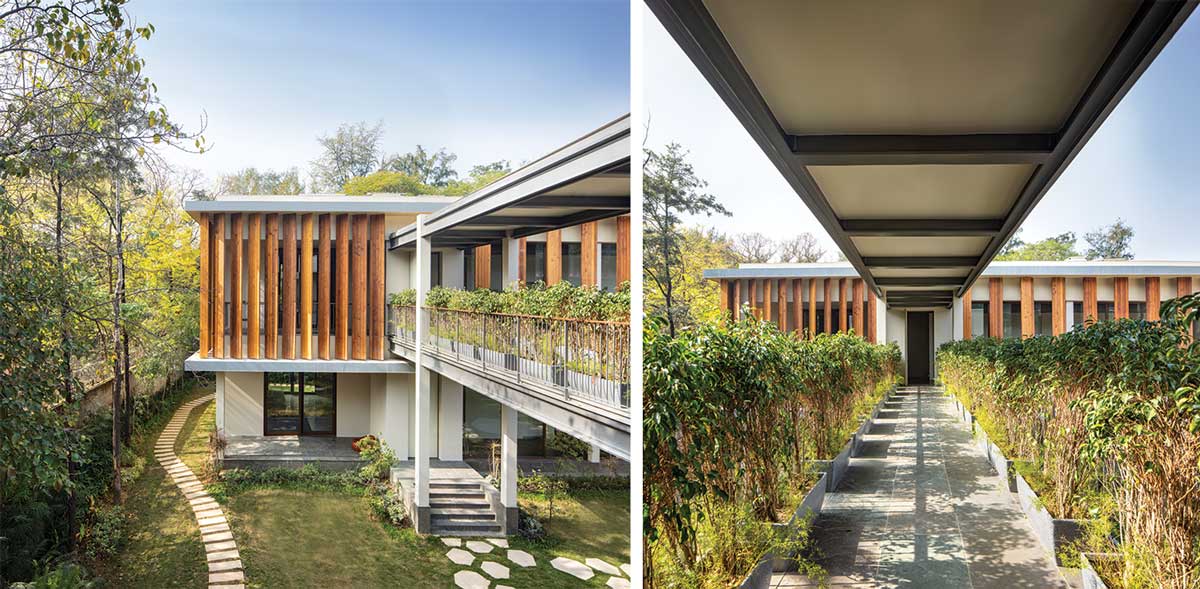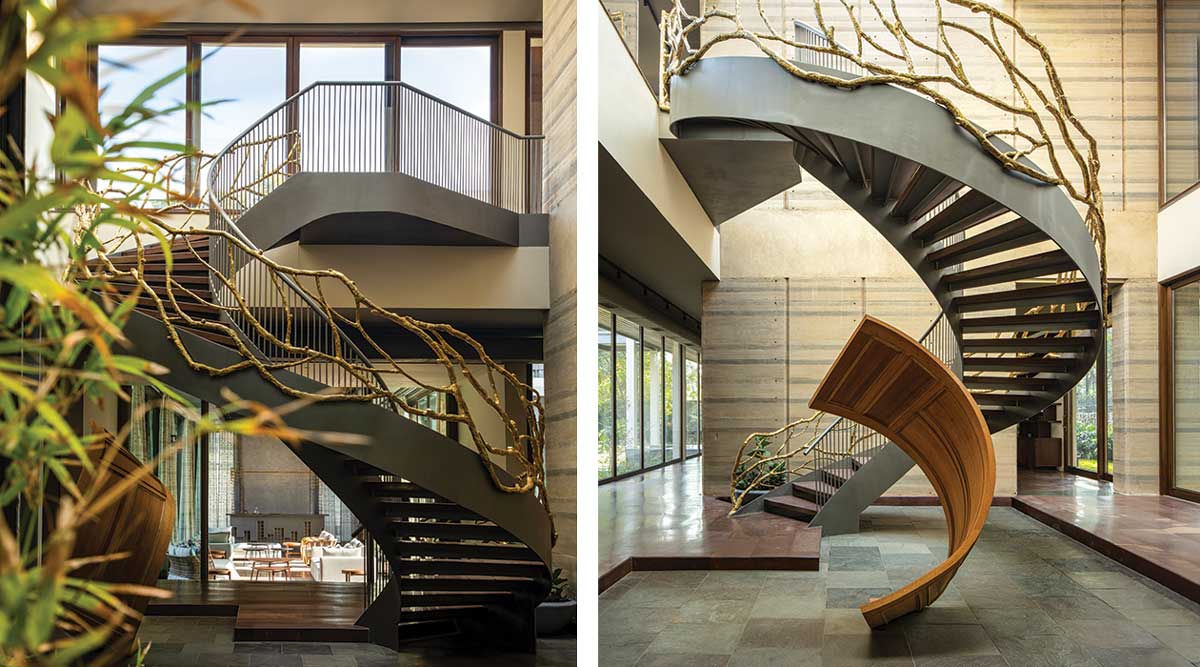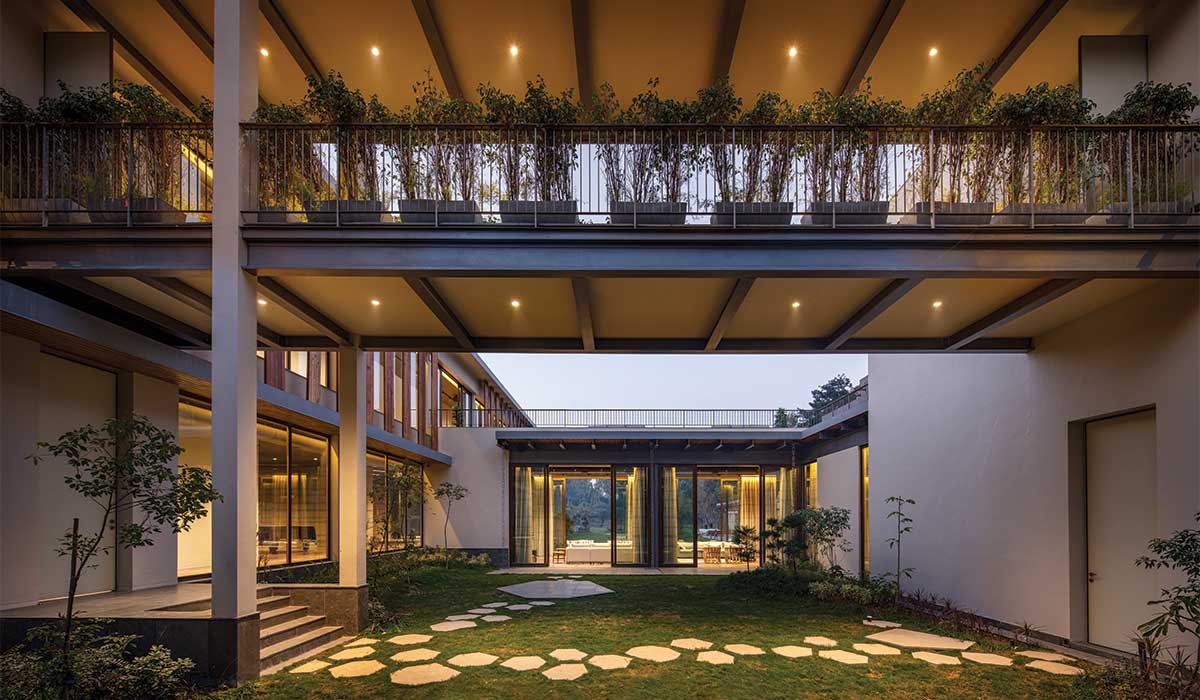
Fact File
Typology: Residential
Site Area: 2.5 acres
Built-Up Area: 20, 000 sq.ft.
Start Date: March 2019
Completion Date: February 2021
Photographers: Niveditaa Gupta, Sagar Chhabra
Products & Brands
ACP: Alstone
Doors: JB Glass
Windows: Artius
Concrete: Ultratech
Sanitaryware: Home Projects Corporation
Wooden Flooring: Span Woods
Terrazo Flooring: Vyara
Indian Stone: Stonera
Italian Stone: Graava
Furnishing: Shades of India
Furniture: Mangrove Collection
Air Conditioning: Ambience Airtech
BMS: Anusha Technovision
Lighting: D41 LED C4, Hifi Solution
Fire Light: Aditya Vohra
Paint: Oikos, Asian
Graphics: Vision DIS Signage
Consultants
Structural: Japan Shah Consulting Engineer
Mechanical, HVAC: Ruman Abid Hussain Consultants
Electrical: SS Consultants
Civil: Studio Lotus
Plumbing: Techno Engineering Consultants
PMC: Save Techno Engineers
Façade: Studio Lotus
Contractor: Antrix Construction
Suburban neighbourhoods are witnessing a proliferation of private farmhouses and bungalows. The Earth and Glass House in suburban New Delhi, is one such weekend retreat. Situated on a two-acre rectangular plot with one half reserved for hosting events, the house is surrounded by farmlands on three sides and a dense urban settlement on its eastern edge. A15 m high compound wall has been constructed along this fringe to ensure privacy and security. Creating a landscaped zone along this wall as a buffer to the development became a starting point for initiating the design scheme.
Envisioned to provide a framework that would accommodate multiple recreational functions, this landscaped zone serves as an extension to the living area. A secondary rammed earth wall used from soil excavated during construction forms a continuous backdrop to the swimming pool. Covered walkways assembled using a grid of light metalwork, interspersed with silver oak trees retained along the site periphery, are designed to further add a layer of landscape and privacy.
The metal armature allows for diverse recreational activities: a DJ deck, small pool house, and a treehouse-like machan. The resultant interstitial space is designed to house vines, creepers, and plants in irrigated troughs along the gridwork to create a dense mesh of vegetation.
The house converges around the idea of living in harmony with nature, facilitating fluid transitions, and providing its residents a sanctuary to unwind and connect with the outdoors
Ar. Sidhartha Talwar Principal, Studio Lotus
The site zoning is derived from the principles of Vaastu. To let in the south sun and bring the outdoors in, a winter court was scooped out, opening the living area to the landscape, and thereby facilitating a seamless line of sight—from the winter court to the lawns on the north. The private spaces flank the living room, and are connected by a terrace garden and a shaded bridge on the upper level.
The house brings together three construction systems: load-bearing walls made of rammed earth, a mild steel framework, and exposed RCC slabs. A key design challenge was to develop the requisite joinery and junction details to cohesively unite these three distinct structural systems.
A driveway leads visitors to the entrance porch, shaded by a 10m long cantilevered volume resting on a load-bearing rammed earth wall and a pair of V-shaped columns. The entryway is marked by a double-height, sky-lit court within which sits a staircase that establishes a visual and spatial connection between the shared and the private spaces. Its brass railing emulates twigs and branches of the nearby trees. An installation resembling a curved timber door mimics the form of the staircase; together, the ensemble injects the space with a sculptural presence.

Designed in the form of a pavilion, the living area features panoramic glazing that ensures the interiors remain day-lit throughout. Like a work of art, a Jenga-inspired bar articulated in concrete and brass serves as a node between the living and dining areas. Beyond, the dining extends into the kitchen and utility spaces.
The overall spatial experience invites inhabitants to explore the tactility of the surfaces that populate the space. Revealing the materiality of the building components is intrinsic to the design vocabulary at the house. In the living and dining area, the overarching narrative of metal, stone, and timber is reinforced through the decor and pockets of furniture. Fashioned out of natural materials such as cane and wood, the custom-made furniture articles express the client’s eclectic tastes and introduce a warm, earthy tonality into the interiors.
The material combination of metal, timber, and stone also resonate across the private spaces and find expression in the bedrooms, the baths, and the vanities. The bedrooms housed on the upper level of the cantilevered block feature timber floors that echo the colour and texture of cedar louvres wrapping around the exterior of the cantilevered block. Due to their tactile quality and colour, the cedar louvres render the facade with a touch of warmth and distinctiveness. Each louvre is also manually operable to grant the desired degree of shade, ventilation, and privacy to the residents.

The bathrooms are fitted with skylights that admit diffused daylight and reveal views of the nearby foliage. The baths employ a palette of timber, agglomerated stone and tiles. Vanities crafted with terrazzo, brass, and copper accentuate the interior expression and bring in an element of understated luxury.
















